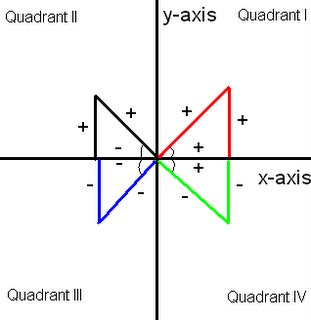The first question ask for the values of Θ on the interval 0°≤ Θ ≤ 360° for the following questions and I have added a picture to help understand:
A)sinΘ<0>Θ>0
B)sinΘ>0 and cosΘ≤0
C)tanΘ>0
D)cosΘ≤0
 Quadrant I:
Quadrant I:sinΘ›O
cosΘ›O
tanΘ›O
Reason: The value/ratio of sin, cos, tan is positive therfore in the 1st quadrant
Quadrant II:
sinΘ›O
cosΘ‹O
tanΘ
 ‹O
‹OReason: The value/ratio of sinΘ is positive while cosΘ and tanΘ are negative
Quadrant III:
sinΘ‹O
cosΘ‹O
tanΘ›O
Reason: The value/ratio of sinΘ and cosΘ is negative while tanΘ is positive
Quadrant IV:
sinΘ
cosΘ›O
tanΘ‹O
Reason: The value/ratio of sinΘ and tanΘ is negative while cosΘ is positive
The question is asking which quadrant is each condition found so:
A) sinΘ
B)sinΘ>O and cosΘ≤O
Answer: Quadrant II because sinΘ is positive and cosΘ is negative and the only quadrant where that is true is in quadrant II
C)tanΘ>O
Answer: Quadrant I and III because the only quadrant where that is true is in quadrant I and III
D)cosΘ≤O
Answer: Quadrant II and III because that only quadrant where that is true is in quadrant II and III
The next thing he explained helped us remember what each variable of the Sin/Cos Wave Formula stood for:
y=A sin B (x-C) +D
y=A cos B(x-C) +D
A-The A represents the amplitude or the direction of opening
B- The B tells us how much the wave is horizontally compressed but unfortunately B is taught in grade 12 not in grade 11
C- The C represents the Phase Shift which tells us the horizontal shift or how far the wave is moved on the x-axis
D- The D represents the Sinusoildal Axis which tells us the vertical shift or how far the wave is moved on the y-axis
With that information in mind we were able to finish the second work sheet which told us to state the amplitude, vertical shift, and horizontal shift.
Well that's my edition of the scribe and I hope this helps everybody that reads this to understand trigonometric functions on the Cartisian Plain. Oh yeah the scribe for tomorrow is the one and only... Mel!issa. Have fun and good night y'all!